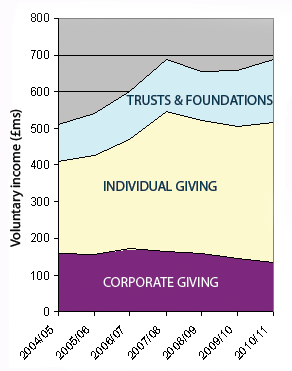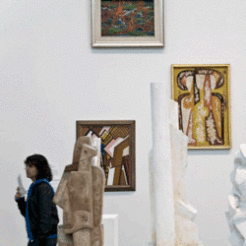Corporate donations to the arts fell last year, but individual giving and the support of trusts and foundations meant that the sector saw a minor increase in voluntary income.
Total voluntary support of the arts in 2011 rose by 4 per cent to £686m, but the make-up of that funding changed significantly year-on-year. The value of donations from the business community fell by 7 per cent to £134.2m, but was compensated for by an increase in grants from trusts and foundations, which increased by a tenth to £170.3m. Giving from individuals also experienced steady growth in 2011, rising by 6 per cent to 382.2m. Corporate giving to the arts remains below 2004/05 levels and well below the pre-recession peak.
Arts & Business, which produces the annual report, said that its “prime concern” is the dive in business support, which has fallen for the fourth consecutive year. Jonathan Moulds, chair of the Arts & Business Leadership Campaign and president of Bank of America Merrill Lynch Europe, said it indicated that “we need to increase awareness across the wider business community and show how our support of the arts can bring many benefits to both communities and to our own organisations.”
The news comes as the arts community attempts to deal with the impact of swingeing cuts to statutory funding of arts and culture, particularly by way of the slashing of the Arts Council England budget.
Hunt claims success, Jarvis warns of arts sustainability
 But secretary for state for culture Jeremy Hunt was keen to laud the news as evidence that his faith in the ability of philanthropy to plug the gap was well placed.
But secretary for state for culture Jeremy Hunt was keen to laud the news as evidence that his faith in the ability of philanthropy to plug the gap was well placed.
“This confounds the critics who said it was a waste of time trying to boost philanthropic giving when times are tough,” he said. “It is also a real tribute to the determination of the cultural sector to boost its fundraising and strengthen the financial resilience of arts organisations. We now just need to keep going.”
But his shadow, Dan Jarvis, while welcoming the news said that the philanthropic increase did not compensate for government cuts. “This simply hasn’t happened,” he said, adding “This is deeply worrying for the long-term sustainability of the arts sector.”
Arts & Business campaign director appeared to back Jarvis’ concerns. “It remains to be seen whether private investment is set to become the dominant funding force of UK culture,” he said.
“What we are seeing is through the adoption of new fundraising and digital channels, arts bodies and individual artists across the UK are capitalising on the unquestionable opportunities that exist for the arts in communities, in the pursuit of creativity and in the delivery of enterprising sponsorships.”
Regional differences
The survey found that different regions are enjoying varying levels of success in attracting voluntary income. While the share of the £686m raised last year which went to the northern regions increased, the south’s share (excluding London) went down. London remains the favoured destination for philanthropic gifts to the arts, attracting 81 per cent of all individual giving. Museums and heritage causes, meanwhile, got a little over half the total funding made available to the sector.
The increases and cuts weren’t uniform across organisations types either. Community arts organisations saw a 28 per cent drop in private investment while film and video organisations had an increase of 30 per cent in voluntary income.









